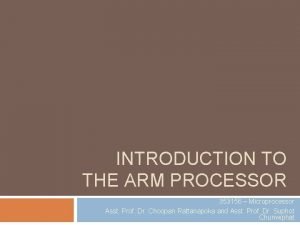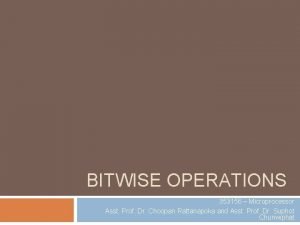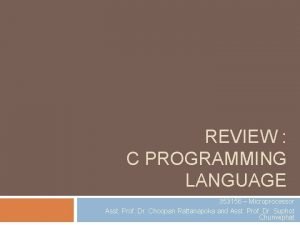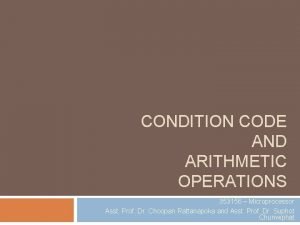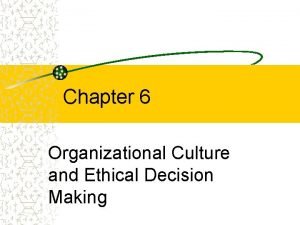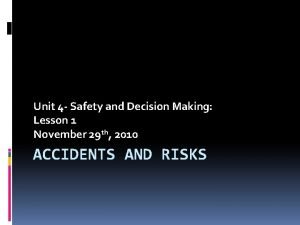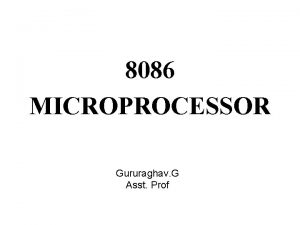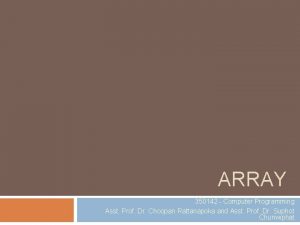MAKING DECISION 353156 Microprocessor Asst Prof Dr Choopan

























- Slides: 25

MAKING DECISION 353156 – Microprocessor Asst. Prof. Dr. Choopan Rattanapoka and Asst. Prof. Dr. Suphot Chunwiphat

Review: C Decision (Control Flow) 2 kinds of if statement in C � if (condition) statement 1 else statement 2 Example 1: if ( a == 5 ) printf(“Hello”); Example 2 : if ( a == 5 ) printf(“Hello”); else printf(“Hi”);

Using Goto and Label C syntax : if ( a == 5 ) printf(“Hello”); else printf(“Hi”); Goto and Label syntax : if ( a == 5) goto Label 1; printf(“Hi”); goto Label 2; Label 1: printf(“Hello”); Label 2: true a=5? printf(“Hello”) false printf(“Hi”)

ARM Decision Instructions (Control Flow) Decision Instruction in ARM � � CMP register 1, operand 2 ; compare register 1 with operand 2 BEQ Label ; branch to Label if equal BNE Label ; branch to Label if not equal B Label ; branch to Label C Code if ( a == 5) goto Label 1; a = a + 5; goto Label 2; Label 1: a = a - 5; Label 2: ARM Code (a maps to R 0) CMP R 0, #5 BEQ Label 1 ADD R 0, #5 B Label 2 Label 1 SUB R 0, #5 Label 2 ; if (a == 5) ; goto Label 1 ; a = a + 5 ; goto Label 2 ; a=a-5

Example 1 Convert the following C program to ARM assembly. Assume that a maps to R 0, and b maps to R 1 if ( a == 5 ) goto Endif b = a + 5; if ( a != 5 ) a = a - 2; Transform to { Do if condition goto-label Endif: a = a + b; b = a + 5; is true Transform to ARM a = a - 2; assembly } CMP R 0, #5 Do always a = a + b; BEQ Endif ADD R 1, R 0, #5 SUB R 0, #2 Endif ADD R 0, R 1

Exercise 1 Convert the following C program to ARM assembly. Assume that a maps to R 0, and b maps to R 1 Do if condition is true Do if condition is false Do always if ( a != 10) { b = a + 10; a = a - 5; } else { b = a + 20; a = a – 10; } a = a + b;

Simple Loop (1) Simple loop in C (goto-label) Loop: i = i + 1; if (i != 5) goto Loop; ARM Assembly (i maps to R 0)true Loop ADD R 0, #1 CMP R 0, #5 BNE Loop i=i+1 i != 5 ? false

Simple Loop (2) In C, normally we use while or for instead of gotolabel while( i != 10) false i = i + 1; i != 10 ? ARM Assembly (i maps to R 0) Loop CMP R 0, #10 BEQ End. Loop ADD R 0, #1 B Loop End. Loop true i=i+1

More on Branch Instructions So far, we branch on Uncondition, Equal, and Not Equal (B, BEQ, and BNE) How about � Greater than > � Greater than or equal >= � Less than < � Less than or equal <= Lucky for us, ARM has these instructions for you. � BGT � BGE � BLT � BLE (Branch greater than) (Branch greater than or equal) (Branch less than or equal)

Example 2 Convert the following C program to ARM assembly. Assume that a maps to R 0, and b maps to R 1 While. Loop: while (a < 5) { if ( a >= 5 ) goto End. While a = a + 1; Transform to b = b + 2; goto-label } goto While. Loop End. While: Transform to ARM While. Loop CMP R 0, #5 assembly BGE ADD B End. While R 0, #1 R 1, #2 While. Loop

Exercise 2 Convert the following C program to ARM assembly. Assume that a maps to R 0, and b maps to R 1 while ( a <= 10) { b = a + 10; a = a - 5; } a = a + b;

If- else if - else In C : if – else if - else if (k == 1) a = a + 5; else if (k == 2) a = a + 10; else if (k == 3) a = a - 10; else a = a – 5; What is the a value after program is executed if assume a = 20 and 1. k = 1 2. k = 2 3. k = 3 4. k = 10 In ARM : (R 0 = k, R 1 = a) Cond 2 Cond 3 CMP R 0, #1 BNE Cond 2 ADD R 1, #5 B Endif CMP R 0, #2 BNE Cond 3 ADD R 1, #10 B Endif CMP R 0, #3 BNE Else. Cond SUB R 1, #10 B Endif Else. Cond SUB Endif R 1, #5

Comparing unsigned data Up until now, BGT, BGE, BLT, and BLE use to compare signed data NOT unsigned data. Example (8 -bit register) A 1 = 0 x. F 5 , A 2 = 0 x 05 � So A 1 > A 2 or A 2 > A 1 ? ? � Signed : A 1 = -1110, A 2 = 510 (A 2 > A 1) � Unsigned : A 1 = 24510, A 2 = 510 (A 1 > A 2) � In ARM, there are instruction for comparing and branching unsigned data BLO � BLS � BHI � BHS � Branch Lower (unsigned) Branch Less or Same (unsigned) Branch Higher or Same (Unsigned)

Example 3 What is the value in R 2 after program is executed ? (1) (2) LDR R 0, =0 x. FFFF 5011 LDR R 1, =0 x 000 ABCD MOV R 2, #5 CMP R 0, R 1 BGE Exit ADD R 2, #1 Exit LDR R 0, =0 x. FFFF 5011 LDR R 1, =0 x 000 ABCD MOV R 2, #5 CMP R 0, R 1 BHS Exit ADD R 2, #1 Exit

How can branch instruction know the output of CMP instruction ? In the process of comparison and branching (CMP), actually, processor does the following steps : � CMP instruction does operand 1 – operand 2 � Update CPSR flags � Branch instruction checks CPSR flags and does the operation Review : CPSR

CMP and CSPR (=) CMP R 0, R 1 ; it does R 0 – R 1 � R 0 1 � � = R 1 (R 0 = 0 x 15, R 1 = 0 x 15) 0 0 0 1 1 1 1 0 0 0 0 N = 0, Z = 1, C = 1, V = 0 Thus, if R 0 = R 1 then Z = 1 0 1 + 1 0

CMP and CSPR (!=) CMP R 0, R 1 ; it does R 0 – R 1 � R 0 1 � � != R 1 (R 0 = 0 x 15, R 1 = 0 x 10) 0 0 0 1 1 1 0 0 0 0 1 N = 0, Z = 0, C = 1, V = 0 Thus, if R 0 != R 1 then Z = 0 0 1 + 0 1

CMP and CSPR (unsigned data >=) CMP R 0, R 1 � R 0 ; it does R 0 – R 1 >= R 1 (R 0 is higher than or same as R 1) R 0 = 0 x. F 0, R 1=0 x 05 1 1 1 1 10 0 R 0 = 0 x 06, R 1 = 0 x 05 0 0 1 1 10 0 N = ? , Z = 0, C = 1, V = 0 0 1 1 0+ 1 1 0 1 0 0 1 1 0 0+ 1 1

CMP and CSPR (unsigned data <) CMP R 0, R 1 � R 0 ; it does R 0 – R 1 < R 1 (R 0 is lower than R 1) R 0 = 0 x 05, R 1=0 x. F 0 0 0 0 1 R 0 = 0 x 05, R 1 = 0 x 06 0 0 1 1 1 1 N = ? , Z = 0, C = 0, V = 0 0 1 1+ 0 1 0 1 1 1+ 0 1

Conclusion : CPSR Flags for CMP Unsigned Data CMP R 0, R 1 N Z C V Remark X 1 X X R 0 = R 1 X 0 X X R 0 != R 1 X X 1 X R 0 >= R 1 (higher or same) X X 0 X R 0 < R 1 (lower) X 0 1 X R 0 > R 1 (higher) R 0 != R 1 AND R 0 >= R 1 X X 0 X X R 0 <= R 1 (lower or same) R 0 = R 1 OR R 0 < R 1

CMP and CSPR (signed data >=) CMP R 0, R 1 � R 0 ; it does R 0 – R 1 >= R 1 (R 0 is greater than or equals R 1) R 0 – R 1 (always positive N = 0, V = 0) Exceptional case : when result of subtraction is overflow R 0 = 0 x 75, R 1=0 x 85 0 1 1 1 0 1+ 0 1 1 01 1 0 0 Carry In (1) XOR Carry Out (0) => V = 1 N = 1 � Thus, to R 1 if N = V then R 0 is greater than or equals

CMP and CSPR (signed data <) CMP R 0, R 1 � R 0 ; it does R 0 – R 1 < R 1 (R 0 is less than R 1) R 0 – R 1 (always negative N = 1, V = 0) Exceptional case : when result of subtraction is overflow R 0 = 0 x 85, R 1=0 x 75 1 0 0 1 0 1+ 1 0 0 0 1 1 10 0 0 1 0 0 Carry In (0) XOR Carry Out (1) => V = 1 N = 0 � Thus, to R 1 if N != V then R 0 is greater than or equals

Conclusion : CPSR Flags for CMP Signed Data CMP R 0, R 1 N Z C V Remark X 1 X X R 0 = R 1 X 0 X X R 0 != R 1 0 1 X X 0 1 R 0 >= R 1 (greater than or equal) 1 0 X X 0 1 R 0 < R 1 (less than) 0 1 0 0 X X 0 1 R 0 > R 1 (greater than) R 0 != R 1 AND R 0 >= R 1 X 1 0 1 X X X 0 1 R 0 <= R 1 (less than or equal) R 0 = R 1 OR R 0 < R 1

Flag Setting Instructions Compare � CMP R 0, R 1 ; update flags after R 0 + R 1 R 0, R 1 ; update flags after R 1 AND R 2 Test � TST ; update flags after R 0 – R 1 Compare Negated � CMN R 0, R 1 Test Equivalence � TEQ R 0, R 1 ; update flags after R 1 EOR R 2

Assignment 7 Convert the following part of C program to ARM Assembly a = 0, b = 0 int a = 0, b = 0; while ( b <= 10) { if ( a < 5) a = a + 10; else a = a - 5; b = b + 1; } a = a + b; b <= 10 ? false true a <5? a = a + 10 false a=a-5 b=b+1 a=a+b
 Objectives of decision making
Objectives of decision making Financial management process
Financial management process 353156
353156 353156
353156 Mu0 processor
Mu0 processor Symbol definition
Symbol definition 353156
353156 353156
353156 353156
353156 353156
353156 Decision tree and decision table examples
Decision tree and decision table examples Laplace criterion example
Laplace criterion example Making decision is a fundamental life skill
Making decision is a fundamental life skill Maut decision making
Maut decision making Cognitive illusions in decision making
Cognitive illusions in decision making Human resource decision making in organizations
Human resource decision making in organizations The role of corporate culture in ethical decision making
The role of corporate culture in ethical decision making Police critical decision making model
Police critical decision making model Consensual purchase decision
Consensual purchase decision Fatalistic
Fatalistic List the steps in the paced decision making process
List the steps in the paced decision making process Planful decision making definition
Planful decision making definition Explore the alternatives in decision making
Explore the alternatives in decision making Improving decision making and managing knowledge
Improving decision making and managing knowledge 5 p's of production management
5 p's of production management Unit 4 lesson 1 decision making
Unit 4 lesson 1 decision making


